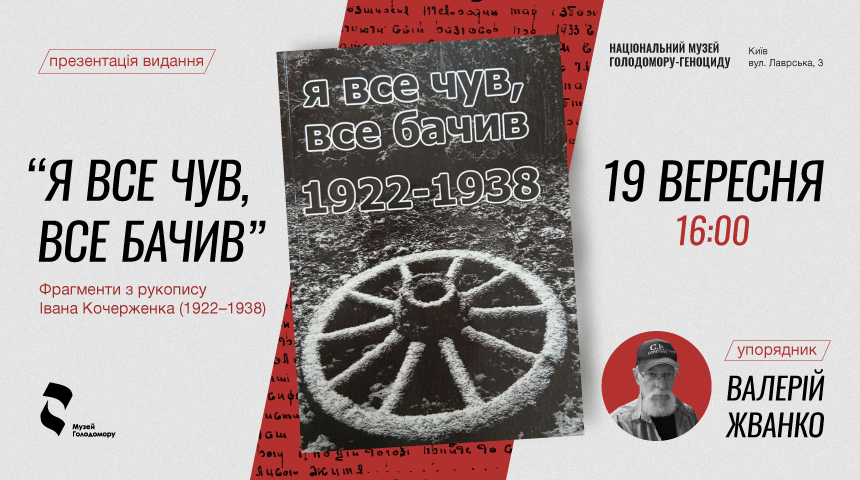Book presentation: “I heard everything, I saw everything”
On 19 September, the Holodomor Museum will host a book presentation of “I Heard Everything, I Saw Everything.” Excerpts from Ivan Kocherzhenko’s manuscript, 1922–1938.
Speakers:
- Oleh Voliansky, Head of the Popelnastiv Village Council, historian;
- Valerii Zhvanko, local historian, journalist, director of the Toloka Cultural and Educational Centre, editor and author of the foreword to the book “I Heard Everything, I Saw Everything”.
- Yuliia Kotsur, PhD, Head of the Oral History Department of the National Museum of the Holodomor-Genocide.
The manuscript of Ivan Khrysanfovych Kocherzhenko, a resident of the village of Shchaslyve in the Kirovohrad region, had been kept for a long time in the personal archive of Ivan Pohorilyi, director of the Shchaslyve school. In 2021, at the request of Oleh Voliansky, head of the Popelnastivska community, it was handed over for research to Valerii Zhvanko, director of the Toloka Cultural and Educational Centre. The local historian was so impressed by what he read that he immediately decided to publish the material he had found, preserving the original language. That’s how the book “I Heard Everything, I Saw Everything” was created.
The publication presents excerpts from the manuscript of Ivan Kocherzhenko, head of the village of Shchaslyve, from the period 1922–1938, who ‘helped build a new, bright future,’ but in reality destroyed the lives of hundreds of people and was himself arrested in 1938 as a counterrevolutionary. As an active organiser of collectivisation and dekulakisation in four villages: Veselyi Barvinok, Dobra Nadiia, Veselyi Rozdol and Shchaslyve, in the Chervonokamyanskyi (now Oleksandriiskyi) district of the Kirovohrad region, Kocherzhenko described the events of that time in detail. The author of the manuscript describes the process of confiscation, distribution and transfer of collective farm property, the eviction of families from Ukraine, peasant revolts and the subsequent fates of those involved in the events.
Ivan Kocherzhenko also touched upon the events of the Holodomor genocide of 1932–1933. In particular, he recounts that in 1932, after harvesting the crops and settling accounts with the state, the local collective farm formed four funds: for seeds, fodder, wages for collective farmers, and a fund for the collective farmers, tractor drivers, and children in nurseries. However, later, an additional plan to deliver grain to the state was issued, and everything that was left had to be given away! Even after giving everything away, the collective farm chairman was unable to fulfil the plan! That was the primary cause of the high mortality rate among residents in 1933. Ivan Kocherzhenko’s memoirs confirm the artificially created genocide of Ukrainians.
The publication will be of interest not only to historians but also to ethnographers and local historians. Ivan Kocherzhenko devoted attention to describing the rituals, clothing, footwear, and diet of the peasants. The book includes recipes for various dishes, the methods of heating and lighting houses, and financial details on farming. There is information about trade, education, and medicine.
The publication was made possible thanks to the financial support of benefactor Yurii Anatoliev.
During the presentation, anyone interested will be able to purchase the book. For those interested in the full text of the manuscript, there is a QR code at the end of the book that you can use to read a digitised copy of notebook No. 1.
During the event, Valerii Zhvanko will donate an extremely valuable find to the museum’s main collection: the 1947 book of accounts with members of the Molotov collective farm in the village of Popelnaste, Chervonokamyanskyi (now Oleksandriia) district, Kirovohrad region. After the event, attendees will be able to view the book and see firsthand how striking the injustice was in the settlements with the peasants for their hard work throughout the year.
Date: Friday, 19 September, 16:00
Venue: Hall of Memory, Holodomor Museum (Kyiv, 3 Lavrska Street, Arsenalna metro station)
Admission is free!
The exhibition will be open until 19 October.
